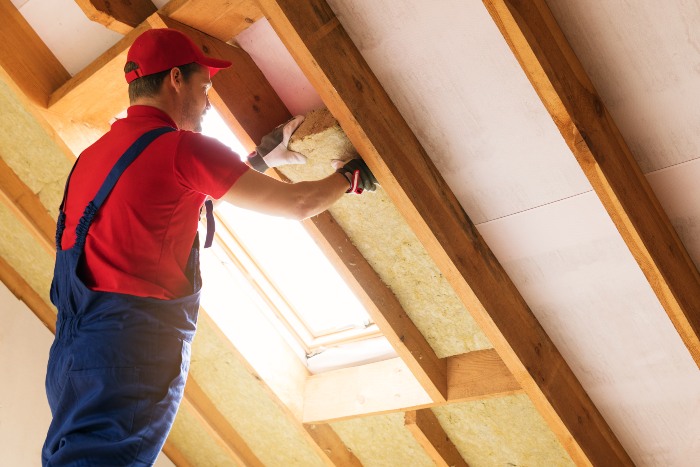How Hot Can an Attic Get in the Summer?
April 03, 2024

Many people consider attic insulation a wintertime necessity. After all, heat rises, so insulation is vital to keep heat inside when it’s cold out. However, attic insulation also affects your summer cooling bills, so it’s worth investing in quality insulation to avoid comfort problems and high energy costs. Learn more about how attic insulation works, why it’s beneficial for home heating and cooling, and what type of insulation you should install.
How Does Attic Insulation Keep Your House Cool on a Hot Day?
Learn how hot an attic can get in the summer, how attic insulation works, why it’s beneficial for home heating and cooling, and what type of insulation you should install.
How Does Attic Insulation Keep Your House Cool on a Hot Day?
Attic insulation acts as a barrier between the inside of your home and the outdoors. During the summer, heat from the sun penetrates your roof and transfers into the attic, allowing temperatures to build up. If your attic floor is not insulated, this heat can seep through the ceiling. A thick layer of insulation slows heat transfer from the attic, making your air conditioner’s job easier.
Check your attic insulation levels by peeking inside the attic hatch. You know you need more insulation if the floor is bare or you can see the joists sticking through the existing insulation. Remember, insulation works best on a tightly sealed attic floor, so patch air leaks around wiring, ductwork, and plumbing penetrations before adding insulation.
3 Tips to Reduce Attic Temperature in Omaha
The temperature in Omaha is sweltering and humid during summer, with temperatures averaging 76°F in July. However, hot winds often push the temperatures above 90°F.
We all feel the heat when summer’s in full swing, especially in the attic. Have you ever popped your head up there while wondering “how hot can an attic get in the summer?”
It’s likely a lot hotter than you’d want it to be.
Excess heat in your home’s attic can lead to humidity and mold growth, which is harmful to your health. The heat can also damage your roof and other home structures. As a homeowner, you’ll want to keep the attic as cool as possible to prevent these problems. Here are 3 tips on how to keep your attic cool in summer.
-
Ventilate the Attic
Just like we love a bit of a breeze on a balmy day, the attic craves ventilation. By ensuring your attic has enough vents, you’re letting hot air escape and inviting cooler air in. This continuous airflow can make a significant difference. Here are a few ways to get proper attic ventilation:
- Add roof vents
- Add soffit vents
- Install gable vents
-
Install Radiant Barriers
Radiant barriers are reflective materials you can install in the attic. When the sun’s rays intensify, this barrier bounces that heat away, preventing the attic from getting hot. These barriers are relatively easy to install and can help reduce cooling costs. However, they don’t reduce heat conduction like thermal insulation.
-
Install Fans or an Air Conditioner
Fans are fantastic at circulating air, ensuring that the sweltering heat doesn’t stay long. The circulation pulls in cooler external air and expels the hotter internal air. Most attics are vented, but if you plan to make the space livable, consider installing air conditioning.
Count on the Pros
While these three strategies will reduce heat buildup, installing insulation is still the best way to cool the attic. Consult the experts at Aksarben Services for advice on the best types of insulation or AC units to install.
Common Summer Problems That Insulation Helps Solve
If you’re wondering whether insulating your attic is worth it, consider these summer problems insulation can help fix:
- High cooling bills: When your air conditioner has to work harder to maintain a comfortable temperature, it uses more energy and raises your energy bills. Attic insulation reduces your AC unit’s energy usage, making it more cost-effective to cool your home during the summer.
- Hot upper floor: If you have a multi-story home, you may notice that the second floor is always hotter than the ground floor. One reason for this is because hot air rises. Another could be that your attic is poorly insulated, allowing hot air to seep into the upstairs living space. Stand on a ladder and place your hand on the ceiling. If it feels warm, you know you’re wasting energy and could benefit from more insulation.
- Increased AC wear and tear: The hot air that enters your home due to poor attic insulation increases the strain on your air conditioning system, leading to increased wear and tear, more frequent breakdowns, and costly repairs. Insulating your attic helps your air conditioner operate at its peak for more reliable performance and a longer lifespan.
Best Types of Attic Insulation
If you decide to install attic insulation, consider your budget, the size and shape of your attic, and the local climate. If you’re unsure how much insulation you need or what type is best, consult a professional who can help you make a cost-effective decision. Here are four of the best types of insulation for the attic:
- Fiberglass insulation is manufactured from tiny glass fibers woven together to create a soft, fluffy material. This affordable, easy-to-install material comes in batts and rolls for a snug fit between attic joists. Loose-fill fiberglass is also available for oddly shaped spaces. No matter what form you choose, the fireand moisture-resistant qualities of fiberglass make it a safe and durable attic insulation.
- Mineral wool insulation, also known as Rockwool, is made from volcanic rock and slag, which is melted and spun into fibers. Mineral wool is denser, heavier, and more water-resistant than fiberglass, making it better at reducing heat transfer, sound transmission, and mold growth. This material comes in batts, rolls, and loose-fill forms, just like fiberglass.
- Cellulose insulation is an eco-friendly option made from recycled paper, cotton, wool, straw, or hemp treated with fire-resistant chemicals. This material effectively reduces heat transfer and is safer to install than fiberglass because it doesn’t cause skin or eye irritation. Cellulose insulation is only available in loose-fill form, so it must be blown into the attic using a special machine.
- Spray foam insulation is the gold standard for attic insulation. It applies wet and then hardens and expands as it dries, creating an airtight, water-proof barrier. Inch for inch, spray foam has a higher heat flow resistance, or R-value, than traditional batts, rolls, and loose-fill insulation. It also fills every nook and cranny, making it great for hard-to-reach spaces. Spray foam is more expensive than other types of insulation and requires professional installation, but the investment could be well worth it.
Schedule AC Services in Omaha, NE
Installing attic insulation is important to keep your home cool and comfortable in the summer, but that’s not the only thing you can do. Maximize AC performance with help from Aksarben. Our experienced HVAC technicians offer a complete range of cooling services, including AC repair, maintenance, and replacement. Call us today at {{phoneNumber}} or contact us online to request AC services in Omaha or La Vista.
Frequently Asked Questions About Attic Temperatures in the Summer
How Does an Attic Get So Hot?
The sun’s rays heat the roof throughout the day, and as we know, when heat rises, it lingers at the highest point in the home—your attic. It’s not uncommon for attics to reach temperatures much higher than the outside, sometimes 20 to 40 degrees more.
Is It Bad for an Attic to Get Too Hot?
Absolutely. Excessive heat can damage items stored in the attic, and prolonged high temperatures can weaken the structural integrity of roof materials, leading to a shorter lifespan.
Will Insulating My Attic Keep It Cooler?
Does insulation keep heat out? Yes, insulation plays a critical role. Attic insulation helps in the summer by acting as a barrier, reducing the heat that enters the attic from the roof or escapes from the home below.
Will Cooling My Attic Cool My House?
Certainly. A hot attic can warm the entire house since that heat seeps through the ceiling and into the living areas. Keeping the attic cool prevents downward heat transfer, making the rest of the home more comfortable.
Does Insulation Stop Heat from Getting In?
While insulation can’t entirely “stop” heat, it dramatically reduces its transfer. Proper attic insulation slows heat movement, helping to prevent external heat from coming inside during the summer and making spaces like your attic much cooler.
